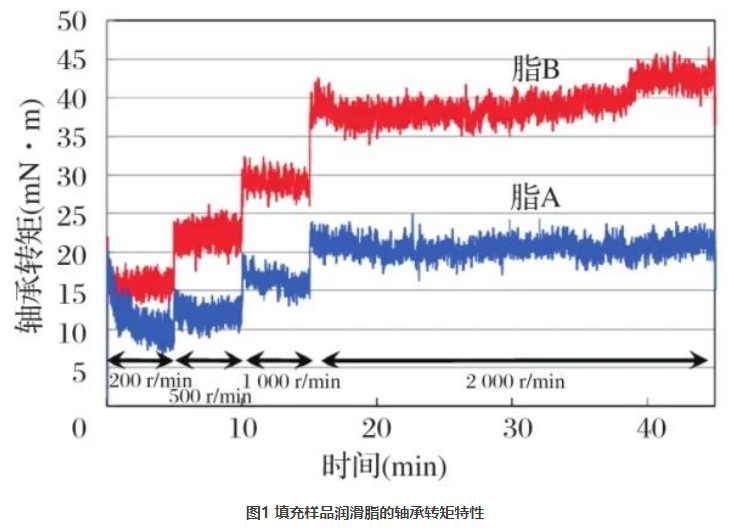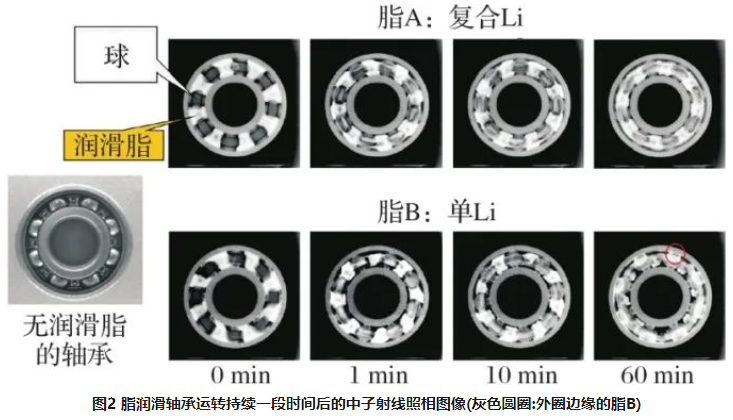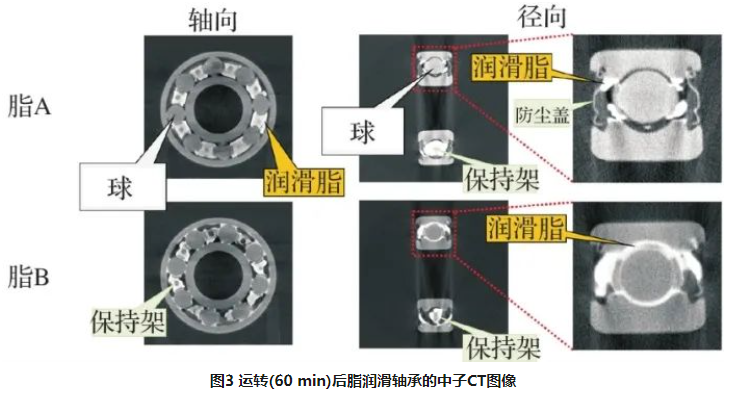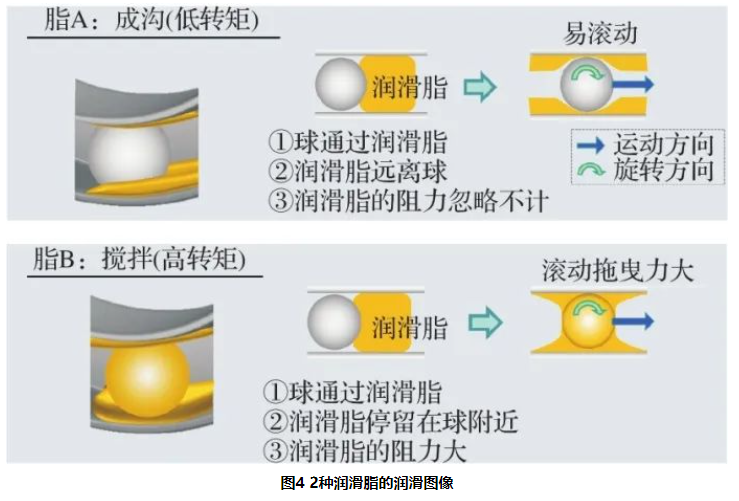
In order to protect the global environment and curb global warming, the development of energy-saving technologies, especially in the automotive and machinery industries, has made progress over the years. According to reports, the electricity consumption of industrial motors such as pumps, compressors and blowers is estimated to account for about 40% of the total consumption in Japan; Therefore, it is very important to improve the energy efficiency of industrial motors. Rolling bearings are widely used for motor shaft rotation support and are lubricated by grease. Greases help extend the service life of bearings; However, there is a conflict that the energy loss (or torque) due to the grease resistance generated by the bearing operation causes the efficiency of the motor to decrease. Nitta et al. pointed out that the reasons for energy loss of rolling bearings can be roughly divided into stirring resistance of lubricants, viscous rolling resistance, friction resistance between the ball and the channel, and friction resistance between the ball and the cage. Cousseau et al. studied the effect of grease on thrust ball bearings by using the friction torque model of rolling bearings. In order to reduce energy loss, choosing a base oil with low viscosity helps to reduce the viscous rolling resistance. In addition, the grease around the bearing channel greatly affects the mixing resistance of the grease, so the fluidity of the grease in the bearing plays a crucial role in the efficiency of the motor.
The fluidity of grease can be indicated by the state of grooving and agitation. In the agitated state, the grease is shear by moving parts (such as balls) and the bearing torque is high due to drag losses. This continuous grease shearing increases the bearing temperature. Grease shear causes the grease to soften, causing the grease to leak from the bearing. In contrast, in the furrowed state, most of the grease is pushed away from the running trench. Due to the removal of grease, the drag loss from grease shearing is reduced. Therefore, the bearing torque reaches a stable low value. In the initial stage of bearing operation, the grease is lubricated in a stirring state, but it can be quickly changed to a furrowed state, which is expected to develop energy-saving greases.
In order to understand the fluidity of grease, it is necessary to visualize the grease in the bearing, however, the methods for non-destructive observation of the bearing interior are limited. Noda et al. studied the distribution of grease in bearings and captured the transient phenomena between agitation and furrowed state by X-ray computed tomography (CT) imaging. However, observation requires some special materials, such as fluorinated resins, fluorinated carbon fiber composites, and glass for bearing retainers, rings, and balls, because heavy elements such as Fe have a strong ability to absorb X-rays. Therefore, it can be said that it is difficult to use X-rays to observe grease composed of light elements in steel bearings. Haruyama et al. visualized grease distribution in bearings using grease with fluorescent particles. In this case, visible light needs to pass through the bearing, so it is necessary to use an outer ring made of transparent material to laser the grease and observe the fluorescence of the grease.
In contrast, neutron imaging does not require this special material for nondestructive observation. Neutrons interact more strongly with light elements, such as H and C, and less so with heavy elements, such as Fe, than with X-rays. Therefore, neutrons can pass through steel bearings and identify grease in bearings. In addition, the neutron energy is low, and the effect of irradiation on grease is negligible. These characteristics of neutrons are suitable for nondestructive observation of grease behavior in conventional bearings and help to understand the fluidity of grease. The purpose of this study is to visualize the grease distribution in bearings using neutron imaging technology. By comparing greases with different bearing torque characteristics, which determine the energy saving performance, the influence of grease flow is discussed.
1 Test method 1.1 Grease sample In this study, two kinds of lithium base greases A and B were used, and compound lithium and single lithium soap were selected as thickeners respectively. Lithium composite is composed of lithium 12-hydroxy-stearate and lithium azelate, and single lithium soap is composed of lithium stearate. These greases usually use API Class I base oils with viscosity class VG32, which are mineral oils composed of paraffin, naphthenes and aromatics. The composition and partial properties of each grease are shown in Table 1.

表1 样品润滑脂
1.2 Bearing torque In order to evaluate the energy saving performance of grease, bearing tests were carried out on the original bearing friction torque tester. The new 6204 bearing is used for each measurement. Before applying the test grease to the bearing, clean the bearing with unleaded gasoline to remove the filled grease. The bearing is filled with 2 g test grease, which is equivalent to about 35% of the bearing space volume. The spatial volume of the bearing is defined as the largest volume that can be filled with grease. A bearing inner ring filled with test grease is mounted on the tester spindle. After applying radial and axial loads to the bearing, a line connected to the force sensor is connected to the bearing seat to detect the bearing torque. The bearing assembly is placed in a housing and temperature is controlled by air convection. After the temperature in the box is stabilized at 25 ° C, the spindle rotates at progressively increasing intervals (200,500,1 000 and 2 000 r/min). The measurement time is 5 min for 200,500 and 1 000 r/min, and 30 min for 2 000 r/min. 1.3 Neutron Imaging Before neutron imaging, the bearings filled with each grease sample were operated at 2 000 r/min for different times, as shown in Table 2. At the Materials and Life Sciences Test Facility (MLF) of the Japan Proton Accelerator Research Center (J-PARC), neutron radiography and CT measurements of grease distributed in bearings were performed using RADEN. RADEN is an instrument for energy resolution and conventional neutron imaging using an intense pulsed neutron beam. The grease-filled bearing sample is fixed on the rotating table and subjected to neutron beam irradiation. Neutrons penetrating the sample are converted to visible light by a LiF/ZnS scintillation screen with a thickness of 0.10 mm and then photographed by a water-cooled CCD camera with a pixel of 2,048 × 2,048. In radiographic observation, the neutron is irradiated along the bearing axis, the field of view is 80 mm×80 mm, the camera exposure time is about 30 s, and the spatial resolution of the transmitted image is about 60 μm. For CT observation, 600 transmitted images were obtained by rotating the sample from 0° to 360° at an interval of 0.6°, and the 3D slice images were reconstructed by filtered back projection.

表2 用于中子成像的轴承的准备
2 Results and discussion 2.1 Bearing torque The energy saving performance of grease is determined by bearing torque test. The torque comparison of bearings filled with grease A and B at different speeds is shown in Figure 1. Compared with fat B containing lithium soap thickener, fat A containing complex lithium based thickener showed lower bearing torque at all speeds. The results may indicate that lipid A is lubricated in a furrowed state and lipid B lubricated in a agitated state under these test conditions. To clarify this hypothesis, neutron imaging as described in the following section was performed.

2.2 Neutron Imaging
The neutron radiographic image of the bearing filled with two greases after operation is shown in Figure 2. A photograph of the grease-free bearing taken by an ordinary camera is also shown on the left of Figure 2. These images were processed so that the gray values brightened as the neutron transmittance decreased in order to understand the correspondence with the CT results described below. Therefore, light colors indicate the presence of greases with low neutron transmission, and dark colors indicate the presence of metal parts with high neutron transmission. In the figure marked 0 min, it is observed that 2 greases *** are initially positioned on the cage surface before the bearing runs. When the bearing runs for 0 ~ 60 min, the grease distribution changes. Focusing on the grease distribution after 60 min of operation, it is observed that the different fluidity of the grease depends on the type of thickener. Grease is observed on the edge of the outer ring of grease B (as shown in the gray circle in Figure 2), in contrast, most of grease A stays on the cage surface. After 60 min of bearing operation, the bearing filled with fat B(but not fat A) has a dust cap oil leakage, which corresponds to the imaging results.

Axial and radial neutron CT images of bearings are shown in Figure 3. The bearing filled with two greases was observed after 60 minutes of operation to study the fluidity of the grease in detail. The axial view of the middle plane of the bearing is shown on the left side of Figure 3. Similar to the radiographic results, lipid A was mainly observed on the cage surface, and lipid B was less than lipid A on the cage surface. As shown in the radiographic image, grease and/or base oil leaking from grease B were found at the edge of the outer ring and not on the cage surface. Lipid B adhering to the ball was also observed. In Figure 3, radial image and enlarged image are shown in the middle and right respectively. The lipid A adhering to the ball is negligible, and there is a void between the ball and the inner and outer rings, corresponding to the grooving state. It was also found that most of the fat A remained on the cage surface, as shown in Figure 2. In contrast, lipid B adhering to the ball is evident on the radial image, which is related to the agitated state. Grease and/or base oil leaking from grease B are observed inside the bearing dust cap, indicating oil leakage from the dust cap. At the end of the test, the torque of the bearing filled with fat B increases, as shown in Figure 1. It can be said that grease adhering to the ball may increase the viscous resistance between the ball and the cage because the separated oil or grease B with a low thickening agent content fills the area near the contact area.

2.3 Lubrication mechanism
FIG. 4 illustrates the lubrication mechanism of grease A and B in terms of grooving and agitation state based on the results of this study. Grease A thickened by compound lithium is lubricated in a furrowed state showing lower bearing torque. When the ball travels through grease A with the bearing, most of the grease stays on the cage surface and hardly sticks to the ball, as shown in the neutron CT image. A small amount of grease is dragged into the contact area. Therefore, the ball rotates smoothly, the mixing resistance of the grease is low, and the bearing torque is reduced. In contrast, grease B thickened by a single lithium soap is lubricated in a stirred state, increasing the bearing torque. Neutron CT images showed that lipid B adhered to the ball while the bearing was running, causing the ball to roll with a higher drag force. Grease adhering to the ball may increase the viscous resistance between the ball and the cage. Grease stuck to the ball can be softened by continuous shearing, which causes oil and/or grease to leak from the bearing dust cover. The separated oil or grease with a low thickener content is more likely to stick to the ball. The neutron imaging technology is of great significance to clarify the relationship between grease behavior and grease formulation in bearings, and is helpful to further develop energy-saving and long-life greases.

3 Closing remarks
Neutron imaging technology enables visualization of the flow and distribution of grease in ball bearings. The images capture important grease behaviors, such as furrowed and stirred states, which have a big impact on energy saving performance. The compound lithium thickened grease is lubricated in a groove state in the bearing, and less grease is adhered to the ball, showing a lower bearing torque through the smooth rotation of the ball. The single lithium soap grease is lubricated in the bearing in a agitated state, and the grease adhering to the ball is obvious, showing higher bearing torque by increasing agitation and viscous resistance. Neutron imaging technology offers the possibility of non-destructively revealing the behavior of greases in mechanical parts, which will contribute to the development of greases with excellent performance.